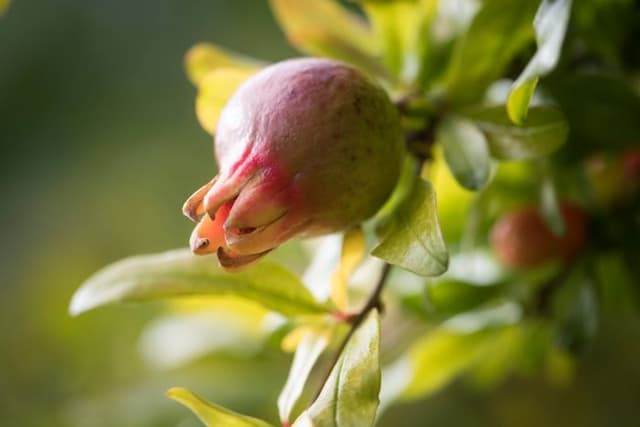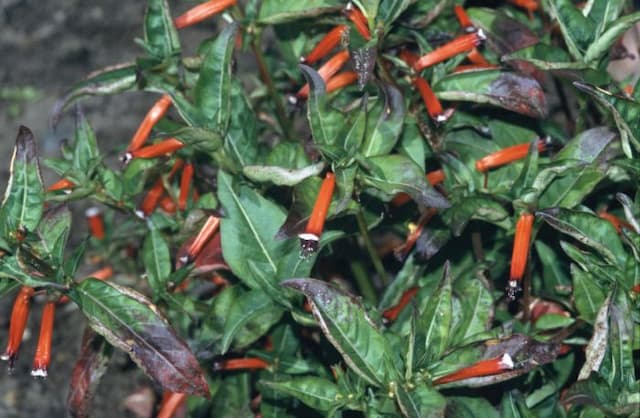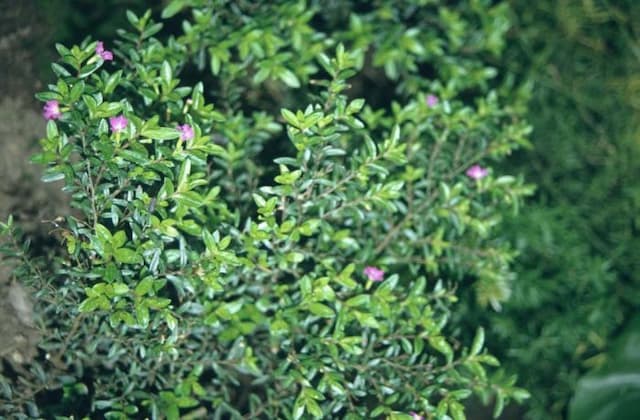Purple loosestrife Lythrum salicaria 'Blush'

ABOUT
Lythrum salicaria 'Blush', commonly known as Purple Loosestrife 'Blush', is a perennial plant that boasts a striking appearance. Its upright stems are adorned with lance-shaped leaves that are finely textured and often arranged in pairs or whorls. The distinctive foliage provides a lush, green backdrop for the delicate blooms. The charm of this cultivar lies in its flowers. The 'Blush' variety produces soft pink blossoms that form in long, dense spikes, creating a feathery effect. These flower spikes are filled with small, individual flowers, each contributing to the overall pastel display. The petals are slightly crinkled, adding a touch of whimsy to the inflorescences, which are beloved by pollinators such as bees and butterflies. The 'Blush' variety is a slightly more subdued version of its more intensely colored relatives, exuding a gentle elegance that can soften the landscape with its serene color palette. The flowers bloom in the warmer months, typically peaking in the summer, and can add a touch of color to gardens or naturalized areas. Overall, Purple Loosestrife 'Blush' is a plant characterized by its robust, verdant foliage and elongated clusters of soft pink flowers, which provide a long-lasting and graceful visual interest throughout its blooming period.
About this plant
 Names
NamesFamily
Lythraceae.
Synonyms
Purple Loosestrife, Rosy Strife, Spiked Loosestrife.
Common names
Salicaria spicata, Salicaria europaea, Lythrum spicatum, Lythrum vulgare, Lythrum salicaria var. tomentosum, Lythrum tomentosum.
 Toxicity
ToxicityTo humans
Purple loosestrife is not commonly known to be toxic to humans. However, as with any plant, individual allergies or sensitivities could potentially cause reactions in some people.
To pets
Purple loosestrife is not commonly known to be toxic to pets either. While it is not considered a dangerous plant, animals can sometimes have adverse reactions to plants that are not typically toxic, so it's always wise to monitor pets if they ingest any plant material.
 Characteristics
CharacteristicsLife cycle
Perennials
Foliage type
Deciduous
Color of leaves
Green
Flower color
Pink
Height
3-4 feet (0.91-1.22 meters)
Spread
1-2 feet (0.30-0.61 meters)
Plant type
Herb
Hardiness zones
4-9
Native area
Europe Asia
Benefits
 General Benefits
General Benefits- Attracts Pollinators: Lythrum salicaria 'Blush' is known to attract bees, butterflies, and other beneficial insects to the garden, promoting pollination.
- Easy to Grow: The plant is hardy and adaptable to various conditions, making it easy to grow in many climates.
- Visual Interest: With its tall spikes of pale pink flowers, it adds vertical dimension and a soft color palette to garden landscapes.
- Drought Tolerant: Once established, it can tolerate periods of drought, making it suitable for water-wise gardens.
- Naturalizes Easily: It can spread and naturalize in suitable environments, creating dense stands that can be used for erosion control.
- Long Blooming Period: The blossoming season extends through the summer months, providing long-lasting floral displays.
- Wildlife Habitat: It provides shelter and food for various wildlife, contributing to a balanced ecosystem.
- Ornamental Seed Heads: After blooming, the seed heads add textural interest to the winter garden.
- Deer Resistance: It is generally resistant to browsing by deer, making it suitable for rural and suburban gardens near natural habitats.
 Medical Properties
Medical Properties- Antidiarrheal: Lythrum salicaria, commonly known as Purple Loosestrife, has been used traditionally for its astringent properties to help alleviate diarrhea.
- Antiseptic: The plant contains tannins and other compounds that have antiseptic properties, which can be used to cleanse wounds.
- Gastrointestinal relief: Purple Loosestrife has been used in herbal medicine to soothe gastrointestinal issues such as dysentery and abdominal pain.
- Anti-inflammatory: Purple Loosestrife has been reported to have anti-inflammatory effects, which may help reduce swelling and soothe irritated tissues.
- Mouthwash: Its astringent properties make it suitable for use as a mouthwash to treat mouth ulcers and sore throat.
 Air-purifying Qualities
Air-purifying QualitiesThis plant is not specifically known for air purifying qualities.
 Other Uses
Other Uses- Dye Production: The leaves, stems, and flowers of Purple Loosestrife can be used to produce a natural dye for textiles, yielding colors from yellow to green depending on the mordant used.
- Photography: Purple Loosestrife has been utilized in the art of solargraphy, where its silhouette is captured over long exposures against the path of the sun.
- Eco-Art: Artists incorporate Purple Loosestrife into eco-art installations to make statements about invasive species and ecological impacts.
- Education: Purple Loosestrife can be a teaching tool in classrooms for discussions about plant biology, ecology, and the effects of invasive species.
- Floral Arrangements: Though invasive, Purple Loosestrife is sometimes used in cut flower arrangements for its striking spikes of pink-purple flowers.
- Biological Control Research: Purple Loosestrife can be used in research focused on biological control methods, such as the use of specific insects that feed on it.
- Garden Contrast: Some gardeners use Purple Loosestrife to create visual contrast, thanks to its tall structure and vibrant blooms, though it must be controlled responsibly.
- Biomass: Research is exploring Purple Loosestrife as a potential biomass crop for producing energy, due to its rapid growth rate.
- Beekeeping: Though invasive, Purple Loosestrife provides a source of nectar for bees at a time when other flowers may not be available.
- Soil Stabilization: In some controlled scenarios, Purple Loosestrife's dense root network has been used to stabilize soil on riverbanks to prevent erosion.
Interesting Facts
 Feng Shui
Feng ShuiPurple loosestrife is not used in Feng Shui practice.
 Zodiac Sign Compitability
Zodiac Sign CompitabilityPurple loosestrife is not used in astrology practice.
 Plant Symbolism
Plant Symbolism- Persistence: Lythrum salicaria, commonly known as Purple Loosestrife, is known for its resilience and ability to thrive in various conditions, symbolizing persistence and the capacity to endure challenging situations.
- Beauty in the wild: As a plant that grows prolifically in the wild and natural wetlands, Purple Loosestrife symbolizes natural beauty and the idea that splendor can be found in untamed environments.
- Struggle and conquest: Due to its invasive nature in some regions, where it overtakes native vegetation, Purple Loosestrife can be seen as a symbol of struggle and conquest over one's surroundings.
- Prosperity and abundance: The abundant and vibrant flowering of Purple Loosestrife could symbolize prosperity and the richness of life, mirroring the plant's bountiful presence in its native habitat.
 Water
WaterPurple Loosestrife 'Blush' thrives best when kept consistently moist but not waterlogged. During the growing season, water the plant thoroughly at least once a week, providing about 1 inch of water to soak the soil. In hotter, drier periods, this may need to be increased to twice a week. Ensure the plant receives approximately 1 gallon of water each time if it's a newly planted specimen, so the water penetrates deeply to encourage root growth. During its dormant season in fall and winter, reduce watering frequency to prevent the soil from becoming too soggy, which can lead to root rot.
 Light
LightPurple Loosestrife 'Blush' prefers full sun but can tolerate partial shade. An ideal spot for this plant is one where it receives at least 6 hours of direct sunlight daily. When planted in too much shade, the plant might not bloom as prolifically and could become spindly as it stretches towards the light.
 Temperature
TemperaturePurple Loosestrife 'Blush' is hardy and can tolerate a wide range of temperatures, successfully growing in USDA zones 3 through 9. The plant can survive minimum temperatures down to -40 degrees Fahrenheit and thrives in temperatures typically found in temperate regions. The ideal growing temperature for Purple Loosestrife 'Blush' is between 55 and 75 degrees Fahrenheit, which encourages healthy growth and flowering.
 Pruning
PruningPurple Loosestrife 'Blush' should be pruned to maintain shape and promote more blooms. Deadheading, or removing spent flowers, encourages the plant to produce more blooms and prevents unwanted self-seeding. Cut back the plant's stems by one-third after the flowering season to keep it compact and prepare it for the next blooming cycle. Annual pruning is usually sufficient for Purple Loosestrife 'Blush'.
 Cleaning
CleaningAs needed
 Soil
SoilPurple Loosestrife 'Blush' thrives in moist, fertile soil with a pH range of 5.5 to 7.5. The best soil mix for this plant is a combination of loamy garden soil, peat or compost to enhance moisture retention, and a bit of sand to ensure adequate drainage. This native wetland plant prefers consistently damp soil conditions.
 Repotting
RepottingPurple Loosestrife 'Blush' generally does not require frequent repotting as it is a hardy perennial that can spread in the landscape. In garden settings, dividing the plant every 2-3 years to manage its growth and prevent overcrowding is advisable rather than repotting.
 Humidity & Misting
Humidity & MistingPurple Loosestrife 'Blush' is tolerant of a wide range of humidity conditions and does not require any special humidity considerations. It naturally grows in wet environments and is more concerned with soil moisture than atmospheric humidity.
 Suitable locations
Suitable locationsIndoor
Ensure moist soil, bright indirect light, and room to grow.
Outdoor
Plant in wet soil, full sun to part shade, space adequately.
Hardiness zone
3-9 USDA
 Life cycle
Life cycleLythrum salicaria 'Blush', commonly known as Purple Loosestrife 'Blush', starts its life as a seed, which upon germination in early spring, develops into a seedling. The seedling grows rapidly, benefiting from ample water and sunlight, eventually forming a robust root system and rosette of leaves. As the plant matures, it develops tall, erect stems with lance-shaped leaves, and by mid to late summer, it begins to blossom, displaying soft pink flower spikes that attract various pollinators. After pollination, the flowers produce small capsules containing seeds that mature by late summer to early autumn. The plant then enters a period of senescence where aerial parts die back with the onset of colder temperatures, while the roots may remain viable, allowing the plant to regenerate the following spring. The seeds that have dispersed can remain dormant in the soil for several years, ensuring the persistence of Purple Loosestrife 'Blush' in the ecosystem through a cycle of growth, reproduction, and dormancy.
 Propogation
PropogationPropogation time
Spring-Early Summer
The common name for Lythrum salicaria 'Blush' is Purple Loosestrife. The most popular method of propagating this plant is by division, typically done in the spring as new growth appears. To propagate by division, carefully lift the plant from the ground using a spade, ensuring a generous amount of root and soil is included. The root mass should then be divided into smaller sections, each with several shoots and a portion of the root system. These divisions can be replanted immediately at the same depth they were growing previously, spaced about 18 inches (approximately 46 centimeters) apart, to allow for adequate growth and expansion. It is important to water the new plants thoroughly after planting to help establish them in their new location.




